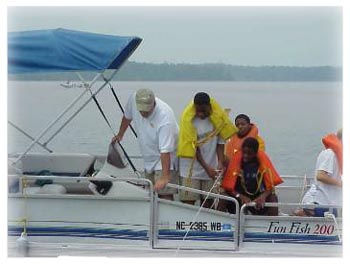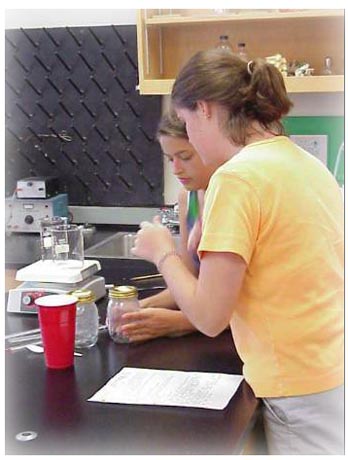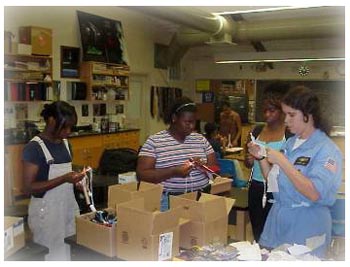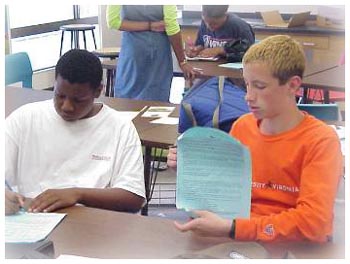- Earth Science: Mr. Sam Fuerst
Students are introduced to earth science in preparation for it being a future requirement for graduation in the North Carolina Public Schools. Instruction is coordinated around the Neuse River Basin with field experiences and sediment analysis. The conditions of the Eno River and the Coastal Areas are performed along with a general overview of NC geology.
- Electronics: Mr. Charlie Payne
The students learn digital electronics by constructing an electronic digital counter on a prototype board. A discussion of logic gates, specific devices such as resistors, capacitors, and diodes, and general elements of digital electronics led to an understanding of the workings of integrated circuits. This developed into a working base-10 counter utilizing a seven-segment digital display that illustrates the translation of binary representations of numbers to decimal numbers.
- Computer Applications and Robotics: Mrs. Margery Enberg
Two components - Robotics and Hyperstudio - are emphasized. In Robotics, students use Lego Dacta Control Lab equipment to build and program mechanical models that are controlled from a computer. Students write program that direct models through a series of movements. In Hyperstudio, students learn to create multi-media story stacks that include text, graphics, sound, movies, animations, and other special effects.
- Chemistry: Mr. Howard Lineberger
Students observed several types of chemical reactions, while learning about the concept of a mole (6.022 x 1023). Ball-and-stick molecular models were created to better visualize the different substances. Students then learned how to write balanced equations representing reactions.
- Math II: Joseph Bufanda
This course introduces topics in Algebra II, such as the real and complex number system, factoring, functions, and matrices. Students implemented their TI-83 graphing calculators after learning the main points and perform data analysis involving linear functions and residuals.
Aside: Poetry: After hard work at Algebra II, students were given a day to explore poetry in a way they might not have had before.
|
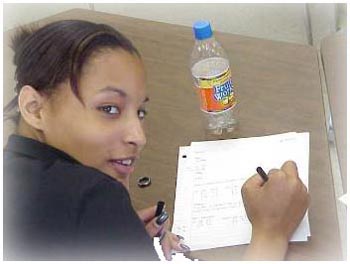
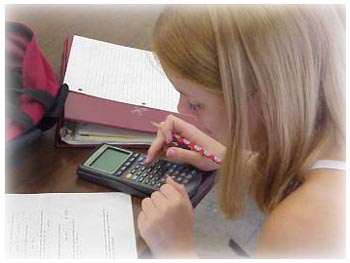 |
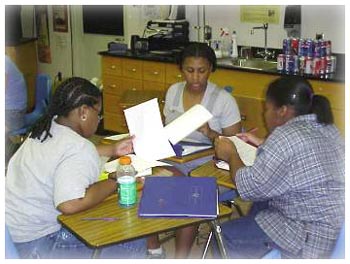
"SAT Prep is an excellent class and has changed my outlook on the test. It
has even given me more confidence, training, and better strategies to use." _
Jessica Murrel
"In Programming Class we had so much fun. We learned how to use many
programs. I now know what it feels like to be a mouse trying to run through a
maze or running through a mine field. Great feats have been accomplished." _
Lisa Punt
"It was very informative and I enjoyed it." _ Albert Ren
|
- Programming A (C++): Dr. Ken Brooks
A lighthearted introduction to computer programming in C++ using hands-on graphics from the very outset. Emphasis on making the process exciting by making beautiful images. The class covers functions, variables, parameter passing, and basic looping control structures.
- Programming B (Karel++): Mr. Julian Cochran
Students work using Karel++, a "robot" language that is very similar to C++, which is object-oriented computer programming. The idea is to familiarize students with topics that parallel concepts in C++ but provide a fun and "safer" way to learn the ideas.
- Language Arts II: Ms. Yolanda Tate
Resumes are created by second year students to better place them in an appropriate internship their third year. Creating resumes is a vital skill in the technological workplace. Organization and content is discussed and the final draft is typed and submitted for review.
- SAT Prep: Mr. Steve Flores
During Week 1, students took the 6 parts of the SAT pre-test. Tests were scored to determine strengths and weaknesses. In Week 2, students used Princeton SAT CD-ROMs to work on adjusting to the math and verbal parts of the test that they needed to improve on.
|


